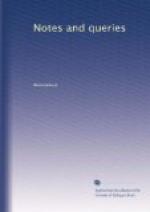NOTES
Latin epigram against Luther and Erasmus.
Mr. Editor,—Your correspondent “Roterodamus” (pp. 27, 28) asks, I hope, for the author of the epigram which he quotes, with a view to a life of his great townsman, Erasmus. Such a book, written by some competent hand, and in an enlarged and liberal spirit, would be a noble addition to the literature of Europe. There is no civilised country that does not feel an interest in the labours and in the fame of Erasmus. I am able to answer your correspondents question, but it is entirely by chance. I read the epigram which he quotes several years ago, in a book of a kind which one would like to see better known in this country—a typographical or bibliographical history of Douay. It is entitled, “Bibliographie Douaisienne, ou Catalogue Historique et Raisonne des Livres imprimes a Douai depuis l’annee 1563 jusqu’a nos jours, avec des notes bibliographiques et litteraires; Par H.R. Duthilloeul. 8vo. Douai, 1842.” The 111th book noticed in the volume is entitled, “Epigrammata in Haereticos. Authore Andrea Frusio, Societatis Jesu. Tres-petit in 8vo. 1596.” The book is stated to contain 251 epigrams, “aimed,” says M. Duthilloeul, “at the heretics and their doctrines. The author has but one design, which is to render odious and ridiculous, the lives, persons, and errors of the apostles of the Reformation.” He quotes three of the epigrams, the third being the one your correspondent has given you. It has this title, “De Lutheri et Erasmi differentia,” and is the 209th epigram in the book.
I have never met with a copy of the work of Frusius, nor do I know any thing of him as an author. The learned writer who pours out a store of curious learning in the pages of Gentleman’s Magazine is more likely than any body that I know to tell you something about him.
Mons. Duthilloeul quotes another epigram from the same book upon the Encomium Moriae, but it is too long and too pointless for your pages. He adds another thing which is more in your way, namely, that a former possessor of the copy of the work then before him had expressed his sense of the value of these “epigrammes devotes” in the following note:—
“Nollem carere hoe libello auro nequidem contra pensitato.”
Perhaps some one who possesses or has access to the book would give us a complete list of the persons who are the subjects of these defamatory epigrams. And I may add, as you invite us to put our queries, Is not Erasmus entitled to the distinction of being regarded as the author of the work which the largest single edition has ever been printed and sold? Mr. Hallam mentions that, “in the single year 1527, Colinaeus printed 24,000 copies of the Colloquies, all of which were sold.” This is the statement of Moreri. Bayle gives some additional information.




